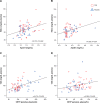Vitamin E tocotrienol supplementation improves lipid profiles in chronic hemodialysis patients
- PMID: 24348043
- PMCID: PMC3849001
- DOI: 10.2147/VHRM.S51710
Vitamin E tocotrienol supplementation improves lipid profiles in chronic hemodialysis patients
Abstract
Purpose: Chronic hemodialysis patients experience accelerated atherosclerosis contributed to by dyslipidemia, inflammation, and an impaired antioxidant system. Vitamin E tocotrienols possess anti-inflammatory and antioxidant properties. However, the impact of dietary intervention with Vitamin E tocotrienols is unknown in this population.
Patients and methods: A randomized, double-blind, placebo-controlled, parallel trial was conducted in 81 patients undergoing chronic hemodialysis. Subjects were provided daily with capsules containing either vitamin E tocotrienol-rich fraction (TRF) (180 mg tocotrienols, 40 mg tocopherols) or placebo (0.48 mg tocotrienols, 0.88 mg tocopherols). Endpoints included measurements of inflammatory markers (C-reactive protein and interleukin 6), oxidative status (total antioxidant power and malondialdehyde), lipid profiles (plasma total cholesterol, triacylglycerols, and high-density lipoprotein cholesterol), as well as cholesteryl-ester transfer protein activity and apolipoprotein A1.
Results: TRF supplementation did not impact any nutritional, inflammatory, or oxidative status biomarkers over time when compared with the baseline within the group (one-way repeated measures analysis of variance) or when compared with the placebo group at a particular time point (independent t-test). However, the TRF supplemented group showed improvement in lipid profiles after 12 and 16 weeks of intervention when compared with placebo at the respective time points. Normalized plasma triacylglycerols (cf baseline) in the TRF group were reduced by 33 mg/dL (P=0.032) and 36 mg/dL (P=0.072) after 12 and 16 weeks of intervention but no significant improvement was seen in the placebo group. Similarly, normalized plasma high-density lipoprotein cholesterol was higher (P<0.05) in the TRF group as compared with placebo at both week 12 and week 16. The changes in the TRF group at week 12 and week 16 were associated with higher plasma apolipoprotein A1 concentration (P<0.02) and lower cholesteryl-ester transfer protein activity (P<0.001).
Conclusion: TRF supplementation improved lipid profiles in this study of maintenance hemodialysis patients. A multi-centered trial is warranted to confirm these observations.
Keywords: end-stage renal disease; hemodialysis; lipid profiles; nutrition intervention; tocotrienol-rich fraction; vitamin.
Figures




Similar articles
-
Supplementation with tocotrienol-rich fraction alters the plasma levels of Apolipoprotein A-I precursor, Apolipoprotein E precursor, and C-reactive protein precursor from young and old individuals.Eur J Nutr. 2013 Oct;52(7):1811-20. doi: 10.1007/s00394-012-0485-3. Epub 2013 Jan 4. Eur J Nutr. 2013. PMID: 23287846 Clinical Trial.
-
Effects of alpha-lipoic acid supplementation on inflammation, oxidative stress, and serum lipid profile levels in patients with end-stage renal disease on hemodialysis.J Ren Nutr. 2012 Mar;22(2):244-250. doi: 10.1053/j.jrn.2011.06.005. Epub 2011 Sep 10. J Ren Nutr. 2012. PMID: 21908204 Clinical Trial.
-
Effects of protein and omega-3 supplementation, provided during regular dialysis sessions, on nutritional and inflammatory indices in hemodialysis patients.Vasc Health Risk Manag. 2012;8:187-95. doi: 10.2147/VHRM.S28739. Epub 2012 Mar 20. Vasc Health Risk Manag. 2012. PMID: 22536073 Free PMC article. Clinical Trial.
-
The effects of tocotrienol supplementation on lipid profile: A meta-analysis of randomized controlled trials.Complement Ther Med. 2020 Aug;52:102450. doi: 10.1016/j.ctim.2020.102450. Epub 2020 May 25. Complement Ther Med. 2020. PMID: 32951713 Review.
-
Cellular protection and therapeutic potential of tocotrienols.Curr Pharm Des. 2011;17(21):2215-20. doi: 10.2174/138161211796957436. Curr Pharm Des. 2011. PMID: 21774780 Review.
Cited by
-
Antioxidants for adults with chronic kidney disease.Cochrane Database Syst Rev. 2023 Nov 2;11(11):CD008176. doi: 10.1002/14651858.CD008176.pub3. Cochrane Database Syst Rev. 2023. PMID: 37916745 Free PMC article. Review.
-
Vitamin E As a Potential Interventional Treatment for Metabolic Syndrome: Evidence from Animal and Human Studies.Front Pharmacol. 2017 Jul 5;8:444. doi: 10.3389/fphar.2017.00444. eCollection 2017. Front Pharmacol. 2017. PMID: 28725195 Free PMC article. Review.
-
N-Acetylcysteine and Atherosclerosis: Promises and Challenges.Antioxidants (Basel). 2023 Dec 4;12(12):2073. doi: 10.3390/antiox12122073. Antioxidants (Basel). 2023. PMID: 38136193 Free PMC article. Review.
-
The effects of vitamin E supplementation on malondialdehyde as a biomarker of oxidative stress in haemodialysis patients: a systematic review and meta-analysis.BMC Nephrol. 2021 Apr 9;22(1):126. doi: 10.1186/s12882-021-02328-8. BMC Nephrol. 2021. PMID: 33832458 Free PMC article.
-
Potential Role of Tocotrienols on Non-Communicable Diseases: A Review of Current Evidence.Nutrients. 2020 Jan 19;12(1):259. doi: 10.3390/nu12010259. Nutrients. 2020. PMID: 31963885 Free PMC article. Review.
References
-
- Collins AJ. Cardiovascular mortality in end-stage renal disease. Am J Med Sci. 2003;325(4):163–167. - PubMed
-
- Schiffrin EL, Lipman ML, Mann JF. Chronic kidney disease: effects on the cardiovascular system. Circulation. 2007;116(1):85–97. - PubMed
-
- Carrero JJ, Stenvinkel P, Cuppari L, et al. Etiology of the protein-energy wasting syndrome in chronic kidney disease: a consensus statement from the International Society of Renal Nutrition and Metabolism (ISRNM) J Ren Nutr. 2013;23(2):77–90. - PubMed
-
- Himmelfarb J, Stenvinkel P, Ikizler TA, Hakim RM. The elephant in uremia: oxidant stress as a unifying concept of cardiovascular disease in uremia. Kidney Int. 2002;62(5):1524–1538. - PubMed
Publication types
MeSH terms
Substances
LinkOut - more resources
Full Text Sources
Other Literature Sources
Medical
Research Materials

